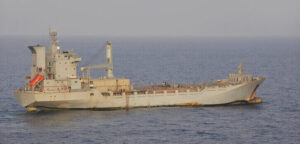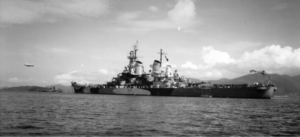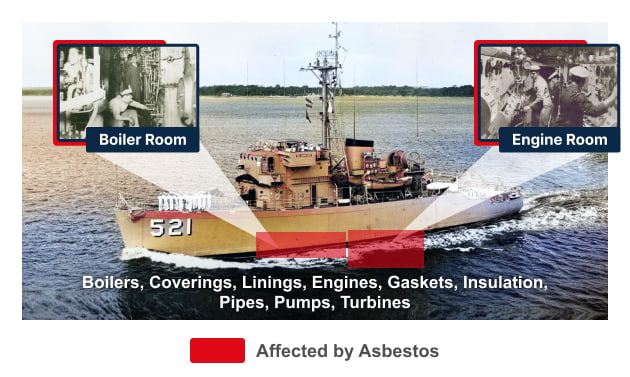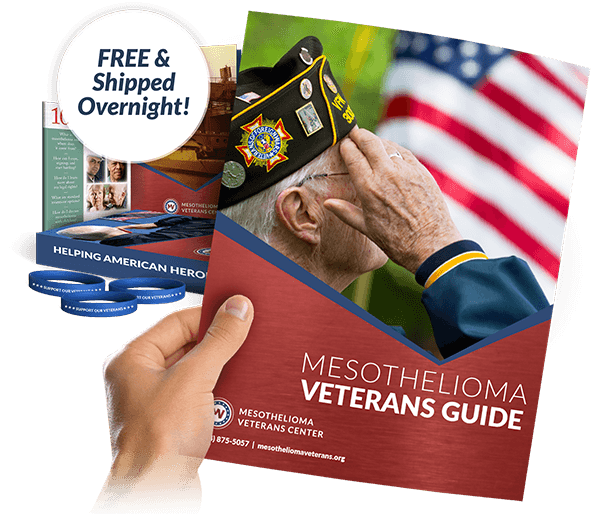Almost all U.S. Navy auxiliary ships used asbestos-containing products before the early 1980s. This put Navy veterans at risk of developing mesothelioma and other asbestos-related diseases later in life. We can help you access military benefits and pursue compensation if you were diagnosed with mesothelioma after exposure to asbestos on an auxiliary ship.
Was Asbestos Used on Auxiliary Ships?
Yes. There are many types of Navy auxiliary ships, and virtually all of them were built with asbestos products for over 50 years.
 Asbestos is a light, naturally occurring mineral that was used to keep auxiliary vessels and other Navy ships fireproof and well-insulated. Yet asbestos exposure can lead to illnesses like mesothelioma, asbestosis, or lung cancer 10-50 years later.
Asbestos is a light, naturally occurring mineral that was used to keep auxiliary vessels and other Navy ships fireproof and well-insulated. Yet asbestos exposure can lead to illnesses like mesothelioma, asbestosis, or lung cancer 10-50 years later.
Types of auxiliary ships that contained asbestos include:
- Aircraft transports
- Amphibious force command ships
- Auxiliary docks
- Crane ships
- Colliers
- Combat stores ships
- Command ships
- Communications relay ships
- Deep submergence support ships
- Destroyer tenders
- Fleet ocean tugboats
- Hospital ships
- Icebreakers
- Minesweepers
- Missile range instrumentation ships
- Motor torpedo boat tenders
- Ocean surveillance ships
- Provisions store ships
- Radar picket ships
- Repair ships
- Seaplanes
- Small and medium harbor tugs
- Submarine tenders
- Surveying ships
- Tankers
- Technical research ships
- Transports
The U.S. Navy is not responsible for exposing veterans to asbestos on auxiliary ships or other vessels. Private companies made and sold asbestos-containing products for decades while hiding the truth.
Veterans with mesothelioma and their loved ones can work with our team to access benefits from the U.S. Department of Veterans Affairs (VA) and connect with top cancer doctors. We may also be able to help you pursue legal compensation after a diagnosis.
Learn about all the ways we can assist you or a Navy veteran you love in our Free Veterans Packet.
List of Navy Auxiliary Ships With Asbestos
Hundreds of auxiliary ships used by the U.S. Navy were built with asbestos-containing products.
Auxiliary ships that contained asbestos included:
- USS Ajax (AR-6)
- USS Alacrity (AG-520)
- USS Amphion (AR-13)
- USNS Apache (ATF-172)
- USS Assurance (AG-521)
- USS Beaver State (ACS-10)
- USS Briareus (AR-12)
- USS Cadmus (AR-14)
- USS Cheyenne (AG-174)
- USS Compass Island (AG-153)
- USS Cornhusker State (ACS-6)
- USS Delta (AR-9)
- USS Diamond State (ACS-7)
- USS Equality State (ACS-8)
- USS Flickertail State (ACS-5)
- USS Flint (AE-32)
- USS Flyer (AG-178)
- USS Fomalhaut (AE-20)
- USS Gem State (ACS-2)
- USNS Glomar Explorer (AG-193)
- USS Gopher State (ACS-4)
- USS Grand Canyon (AR-28)
- USS Grand Canyon State (ACS-3)
- USS Green Mountain State (ACS-9)
- USS Gudgeon (SSAG-567)
- USNS Hayes (AG-195)
- USS Hector (AR-7)
- USS Jason (AR-8)
- USS Keystone State (ACS-1)
- USNS Kingsport (AG-164)
- USS Klondike (AR-22)
- USS Liberty (AG-168)
- USS Markab (AR-23)
- USS Mississippi (AG-128)
- USS Monob One (YAG-61)
- USNS Phoenix (AG-172)
- USNS Provo (AG-173)
- USNS Pvt. Jose F. Valdez (AG-169)
- USS Saluda (YAG-87)
- USS Sequoia (AG-23)
- USNS Sioux (ATF-171)
- USNS S.P. Lee (AG-192)
- USNS Spokane (AG-191)
- USS Utah (AG-16)
- USNS Vanguard (AG-194)
- USS Wyoming (AG-17)
The list above is just a small sample of the many auxiliary vessels and other Navy ships that used asbestos. Many different types of auxiliary ships were built with asbestos-containing materials.
In total, it’s believed that thousands of U.S. Navy ships contained asbestos, putting millions of military service members who served on them at risk of mesothelioma decades later.
Which Asbestos Products Were Used on Auxiliary Ships?
Hundreds of products that were built with asbestos could be found on auxiliary ships before the risks became public knowledge in the early 1980s.
Products containing asbestos on auxiliary ships included:
- Boilers
- Coverings
- Electrical wiring
- Engines
- Gaskets
- Insulation
- Linings
- Pipes
- Pumps
- Turbines


Horrifically, the health risks of asbestos were hidden from U.S. Navy personnel for decades by manufacturers. These companies put brave Navy service members in danger of mesothelioma, all in order to make a profit.
You may qualify for VA benefits, medical care, and compensation if you were exposed to asbestos on auxiliary ships and now have mesothelioma. Find out more in our Free Veterans Packet.
Jobs With a High Risk of Asbestos Exposure on Auxiliary Ships
There is no safe amount of asbestos exposure. Any Navy veteran who was exposed to asbestos on auxiliary ships is at risk of developing mesothelioma later in life.
However, those at greatest risk worked directly with asbestos products every day as part of their jobs aboard Navy auxiliary ships and other vessels.
Navy jobs with a high risk of exposure to asbestos on auxiliary ships included:
- Boiler tenders
- Electricians mates
- Machinist mates
- Plumbers
- Shipyard workers
Navy personnel in these roles often handled, repaired, or replaced asbestos-containing products like insulation or wires, which could send asbestos dust and fibers into the air.
If the sailors breathed in or swallowed the fibers, they would be at risk of mesothelioma later in life.


High-Risk Asbestos Exposure Areas on Auxiliary Ships
Asbestos-containing products could be found throughout auxiliary ships, particularly in areas that generated heat.
High-risk locations on auxiliary ships include:
- Boiler and engine rooms: Sailors who worked on boilers or engines may have encountered asbestos in cracked gaskets and insulation.
- Pump rooms: These rooms contained asbestos-laden gaskets and pipes. The confined area of pump rooms left little space for stray asbestos fibers to go if disturbed, meaning it was easier for sailors to breathe them in or swallow them.
- Turrets: Turrets and large guns required a lot of insulation, which was often made from asbestos. Some of the materials for handling turrets, like insulated gloves, may have also been made of asbestos fabric.
Those working in these areas aboard auxiliary ships were more likely to be exposed to asbestos, which increased their risk of developing mesothelioma decades later.
The Mesothelioma Veterans Center can help veterans with mesothelioma get VA benefits and pursue compensation after a diagnosis. Call (877) 450-8973 now.
History of Asbestos on Auxiliary Ships
The U.S. military relied on many different types of auxiliary ships to supply its main fleet. For decades, almost all of these vessels contained asbestos-based products.
Auxiliary ships were a key part of the U.S. Navy before World War I. However, starting in the 1930s, asbestos-based materials were regularly used by the Navy to construct or refurbish auxiliary ships and other vessels.
In World War II, the auxiliary fleet became a permanent part of the U.S. Navy — and by this time, nearly all ships were built with asbestos due to government mandates.
It’s believed that millions of Navy service members were exposed to asbestos on auxiliary ships and other vessels. Over 4.5 million people suffered exposure just by working in Navy shipyards, according to the New York Times.
Navy service members didn’t know that asbestos on auxiliary ships was harmful until it had been in use for decades. Manufacturers of asbestos products knew the risks but hid the facts to make a profit.
Almost all asbestos-containing products were removed from auxiliary ships and other Naval vessels after the risks became public knowledge.
Still, thousands of veterans develop mesothelioma each year since this cancer can take decades to form after exposure.
VA Benefits & Compensation for Navy Veterans Harmed By Asbestos on Auxiliary Ships
U.S. Navy veterans who developed mesothelioma or other asbestos-related diseases following their military service may qualify for VA benefits, compensation, and other helpful resources.
Learn about the resources that we may be able to help you access below.
Mesothelioma VA Benefits
The VA awards a wide range of medical and financial benefits to veterans with mesothelioma.
Top mesothelioma VA benefits include:
- Disability compensation often worth $3,946.25 per month
- Free or low-cost medical care from VA hospitals
- Survivor benefits
The VA typically rates veterans with service-connected mesothelioma as 100% disabled, allowing them to get the highest disability payouts and lowest health care copays.
Our VA-accredited attorney, Eric Hall, can help you file for mesothelioma VA benefits or increase your VA rating to 100% for free if you are eligible. Get started right now.
Mesothelioma Lawsuits
Veterans with mesothelioma may be eligible to file mesothelioma lawsuits against companies that made and sold the asbestos-containing products that made them sick.
These claims typically award $1 million or more, which can help pay for a veteran’s medical bills, basic living expenses, and more. The U.S. Navy and government are not sued, and veterans can still file for VA benefits.
Our team can help you file a mesothelioma lawsuit for compensation. Call (877) 450-8973 now to find out if you may be eligible.
Asbestos Trust Fund Claims
Many manufacturers of asbestos-containing products filed for bankruptcy to avoid lawsuits but were forced to set up trust funds to pay victims. Today, there’s an estimated $30 billion still available across all asbestos trust funds.
We can determine if you or a loved one qualifies for asbestos trust fund compensation, VA benefits, and mesothelioma lawsuits.
Help for Navy Veterans Exposed to Asbestos on Auxiliary Ships
Brave U.S. Navy veterans who were exposed to asbestos on auxiliary ships decades ago may now face another battle with mesothelioma.
The Mesothelioma Veterans Center team stands ready to help these veterans in any way we can.
Work with our team to access:
- Mesothelioma VA benefits
- Cancer doctors and hospitals
- Legal compensation
- Other top resources to help navigate life after a diagnosis
Thousands of other U.S. veterans and families have put their trust in the Mesothelioma Veterans Center to get the VA benefits and resources they need.
Get our Free Veterans Packet to explore all the ways we can assist you.
Asbestos on Auxiliary Ships FAQs
Was asbestos used on ships?
Yes, asbestos was used on hundreds of auxiliary ships and other Navy vessels to keep various components durable, fireproof, and well-insulated.
That said, the use of asbestos on auxiliary ships put Navy personnel at risk of developing aggressive cancers like mesothelioma 10-50 years later.
Navy personnel and the general public didn’t know the risks of asbestos until it had been in use aboard Navy ships for decades, as manufacturers hid the risks.
When was asbestos banned on ships?
The U.S. Navy largely banned the use of asbestos on auxiliary ships and other vessels in the early 1980s.
Major renovation efforts were undertaken to remove asbestos from the Navy fleet, and no new vessels were made with the toxic substance.
Still, a small handful of Navy ships in use today may contain asbestos-based products, as removing all of them was impossible.
In these cases, the Navy assesses the safety of the asbestos products to ensure they don’t pose a threat.
Which U.S. Navy ships had asbestos?
Hundreds of U.S. Navy auxiliary ships contained asbestos, including the USS Ajax, USNS Apache, USS Green Mountain State, and USNS S.P. Lee.
Besides auxiliary vessels, almost every other U.S. Navy ship built between the 1930s and early 1980s had asbestos-containing products aboard.
Call (877) 450-8973 now to see if you or a loved one served on an auxiliary ship that used asbestos and get VA benefits and other helpful resources after a mesothelioma diagnosis.
Where was asbestos used aboard U.S. Navy auxiliary ships?
Boiler rooms, engine rooms, and pump rooms had especially high amounts of asbestos-based products like insulation and gaskets inside and around them.
Navy sailors who handled asbestos on auxiliary ships were put at risk of mesothelioma decades later.
Can I access VA benefits after asbestos exposure on an auxiliary ship?
Yes, you may qualify for VA benefits if you were exposed to asbestos on auxiliary ships and now have mesothelioma or another serious health problem.
The VA typically assigns a 100% disability rating to veterans with service-related mesothelioma, allowing you to maximize your benefits.
Get help filing for mesothelioma VA benefits or increasing your rating to 100% by working with our team.


